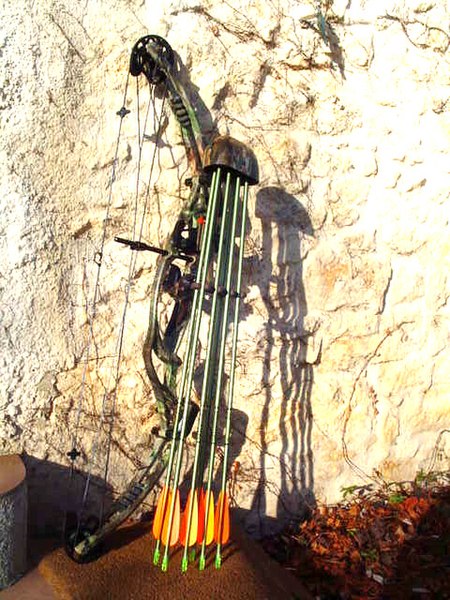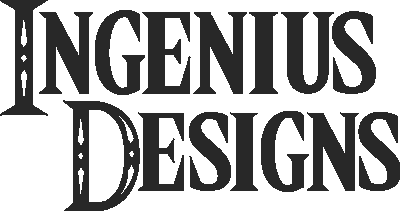In some of our Link Cosplay pictures (ie, Fyrus or Freezard), you may have noticed a unique accessory on Link's back: a quiver!
During the Legend of Zelda Cosplay Project we tried to leave Link's items and an accessories to the imagination as much as possible...but if we were going to have any archery pictures then it was important to also have a quiver to shoot from.
This quiver would be a unique creative challenge, however. In the pre-Breath of the Wild games we selected for the project you never see any of Link's items except his tunic, sword, shield, and the occasional specialty boots or gauntlets. We definitely never see his quiver.
So, this accessory needed to be fully functioning, but also fully concealable.
Fortunately, battling cartoon physics is just the kind of challenge I relish!
Designing the Quiver
Half of the struggle with this piece was figuring out how to make it work.
Where to Put it?
There are a lot of places you can put a quiver.
In the middle ages, longbow archers often brought arrows to a battle in bundles or barrels and stored them in the ground. This is very efficient if you're an archer exclusively, but it wouldn't work for Link, who switches frequently between long-range and short-range weapons in the midst of a battle.

Image from: History for Kids.
Some bow hunters carry their arrows on their bow. This works best with larger compound bows, however, and only allows for a few arrows to be carried at a time (fine if you only plan on shooting one deer). More importantly, this wouldn't work for Link because if he stored his arrows this way we would see it in the game...and obviously we don't.

Image from: Wikimedia Commons.
Much more popular and traditional is the side quiver suspended from the belt. This is convenient for drawing arrows quickly, quietly, and with efficiency of movement. The disadvantage is, if you plan on doing a lot of traveling, this type of quiver can become annoying as it flaps around on the hip.
Link actually uses this type of quiver in Breath of the Wild, but our Cosplay project was based on the games predating this, and we don't see a side quiver in any of those games, so as practical as it is, that design was out.

Image from: Ravenswood Leather.
Last, but not least, is the ever-popular back quiver. Although not very historically accurate, this type of quiver looks great and is the most commonly seen design in films and popular media.

The back quiver also has the additional advantage of being very convenient for traveling without bouncing on your thigh or spilling arrows all over the place (BotW Link has my infinite pity on that account).
Most importantly, this design was the best choice for Link, because it was the only type of quiver that could be naturally concealed under Link's clothing. Link has a shield on his back for most of the game, so it's easy to imagine that his arrows are stored in a quiver underneath.
How to Attach It?
Once I'd decided on a back quiver, the next question was how Link should wear it.
Most back quivers are slung over the shoulder on a single strap. The problem with doing this for Link is that I was trying to make the accessory as unobtrusive as possible, and a second strap running beside his baldric (back sheath for swords) would be an obvious deviation from the classic look of the character.
I decided I would need to make the quiver a removable attachment right on the baldric, but how?
One option was to strap the quiver to the side of the Master Sword's sheath Legolas-style:

Image from: Hub Pages.
This approach would allow the quiver to fit under the shield, but it would look asymmetrical and I would run the risk of throwing the sword/shield combo off-balance and changing the classic Link silhouette. Plus, I would have to build straps into the sheath which would look odd if Link wasn't wearing it all of the time.
I could also try to put the arrows right on top of the sword sheath. This would balance things visually and physically, but could potentially create so much bulk that the shield wouldn't fit over it without making Link look like a long lost Teenage Mutant Ninja Turtle!

Image from: Tumblr.
In the end, I decided on a design that was a compromise between these two alternatives. The quiver would fit over the sheath, but be thin in the middle, and thick on either side.

If that's unclear, just keep reading. It will make sense when I get to the step-by-step.
What Would it Look Like?
Once I had the basic structure figured out, I started sketching designs.
Across his many adventures, Link has sported a lot of quivers.

So, rather than trying to replicate any one quiver specifically, I decided to design my own, inspired by themes from the entire Zelda franchise.
What design? Well...that's what the rest of this post is about, isn't it?
Building the Quiver
Concept sketches in hand, I approached the big leap between a great idea and a great execution.
This was my very first foray into leathercraft. It was quite an adventure for me, so I took some pictures of progress points along the way. As a result, this is one of the very few projects that I actually have this type of "how to" pictures for.
The Outer Shell
Rather than try to make the unique concave shape of the quiver out of a single piece of leather, I decided I would create one rounded outer piece and then attach it to a second interior piece that was formed around the Master Sword scabbard, like so:

I knew that I was going to want to work with hardened leather for this project (who wants a floppy quiver anyway?). To harden leather you first have to soften it in hot water, then stretch it into the shape you want and let it dry. I won't get into the nitty gritty in this post, but if you want to learn more about hardening leather, check out my Kazakh Pauldron article.
In order to pull off this "stretching into shape," I first needed a form to stretch around.
I built a mockup of the inside of the quiver by nailing scraps of balsa wood to a length of 2x4, and then carving it into the subtle hourglass shape I wanted for the quiver.

Around this I hardened strips of leather. It would have been better, of course, to use only one piece of leather, but as I said before this was my first attempt at leathercraft, and I only had smaller scraps to work with at the time.

You’ll notice that the rough underside of the leather is facing out, with manufacturer's stamps on it and everything.
Normally you would never want this on the outside of your leather piece. I did this because I knew none of it would actually be visible. In the next step, I glued brown suede all over the hardened shell.
No hardening was necessary this time because suede has a natural stretch to it, and took on the hourglass shape without any wrinkles, cutting, or other coaxing. Trying to harden suede is a really bad idea, anyway.
On top of the suede, I planned to put a decorative cut of thick, uncolored leather. I used butcher paper to measure out the correct dimensions…

…and then I traced the paper cutout onto a single piece of leather and trimmed it into shape using a box cutter.

Now, before attaching this piece to the rest, I wanted to gussy it up a bit with some custom tooling. I started by using a beveler on all of the edges to give it less of a more professional, less factory-cut appearance.
Then, I slightly dampened the leather with a sponge so it would hold whatever shape I pressed into it, used some calipers as an impromptu wing divider, and pressed lines along the outside edges. I cut partway through the leather with my box cutter (in retrospect, this would have been better done with a swivel knife) and then used a background stamp to put a textured pattern in the empty space between the edges.

Small cuts partway through the leather helped to define the edges.

A background matting stamp was used to add texture between the edges.
Finally, I applied Eco-Flo Super Shene to the entire decorative piece. Products like Super Shene are designed to seal in dyes, protect leather from the elements, and provide an attractive finish all at once.
For the circle at the center of the quiver I had a special design in mind—a pattern of intertwined celtic trinity knots which strongly suggested the Triforce while also grounding the quiver in the real world and making it general enough that it could be used in many different costumes.
I was able to make this design using only three leather stamps, a box cutter, and a little packing tape. How I did this is a subject for a whole other post, so stay tuned!
I dyed the background of the trinity knot/triforce (trinityforce?) dark brown so that the design would pop.The "trinityforce" design was beveled, and the background was stamped and dyed for contrast.

In the end, I decided to go back over the "trinity-force" in gold paint for extra contrast, so I need not have so painstakingly avoided dyeing all the positive space in the design. Still, it was a good learning experience. Leather sealant/finish was applied with a dense kitchen sponge.

At this point, I was ready to put the pieces together.
I glued the decorative piece onto the suede first, just to keep it in place, then I drilled small, evenly-spaced holes along my edges and stitched through the holes with waxed thread.

I used the world’s most basic stitch and a normal large sewing needle. If I were to do it again (now that I’m more experienced), I would have used the stronger saddle stitch and a needle specifically made for leather, but I did what I could with what I had and it still turned out looking pretty darn cool!
The Inner Shell
So far so good. Most of the hard work was done at this point, but I still needed a way to attach this outer shell to the Master Sword scabbard.
To do this I covered the scabbard with saran-wrap, and (using the same hardening technique as before) shaped another piece of leather to match the contours of the scabbard exactly.

Once this was done, I cut the back of the outer shell so that the two would fit together the way I’d planned.

The inner shell fit the scabbard so perfectly that it would stay attached without any help, but I figured that too much jostling with a quiver full of arrows might dislodge it.
So, for extra security I punched holes in the sides of the shell, inserted eyelets (to protect the holes…and just to look nice), and then ran strings of leather lace through the holes.
That way, the two sides of the inner shell could be drawn even tighter together around the scabbard, and the quiver could be tied right to the Master Sword.

I stitched the inner and outer shells together, and the quiver was almost finished!
Finishing Touches
As great as the quiver looked from front and back, it still had a hole in the bottom, and it wouldn’t be much good for holding arrows until I fixed that!
I held a piece of paper up to the hole, and traced its dimensions. Then I cut out a piece of leather the same size.
Stitching this in place was tricky. I couldn’t use the same basic up and down stitch I’d used before, because once most of the bottom was stitched in I could no longer reach inside to push a needle back out.
I needed a stitch that would only ever require me to push my needle down through a hole into the quiver interior, and would never require me to pull one up and out.
To do this I did a baseball stitch backward. In a normal baseball stitch you only ever see threads coming up and out of the leather…

Image from: Wikimedia commons.
…but turn it inside out and you get just the opposite!
The final touch for the whole project was a little trim of red fox fur I’d gotten when I lived in Alaska.
This not only looked fantastic, but it was also quite practical. The fur added just enough padding around the mouth of the quiver that when an arrow was inserted it would stay exactly where it was put, and would not rattle around noisily.
Summary
At last the quiver was finished (and none too soon, since it was a Christmas Present)!
What better way to celebrate finishing such a project than with a cosplay photo shoot!

I hope you’ve enjoyed this little how-to post. Stay tuned for future articles which will expound on creating leathercraft on a budget.
Remember, this was my very first leather creation. I’ve done a lot more (and fancier) things since, but even when I had next to no skills or experience, I was able to make something I’m still very proud of.

There’s no reason to be intimidated by traditional artistic mediums like leathercraft, chainmaille, or bone carving. If something interests you then I encourage you to go out there and try it!
And, if you have questions along the way, I’ll be happy to share what I can and continue to learn alongside you!







